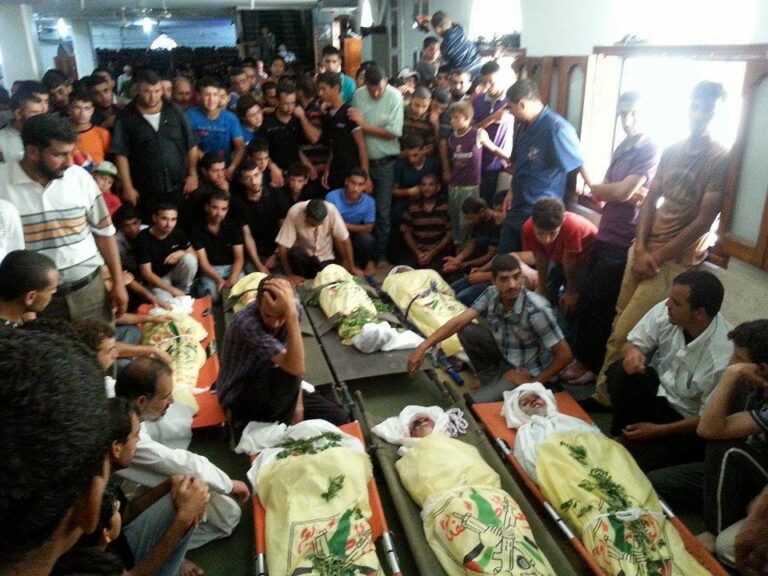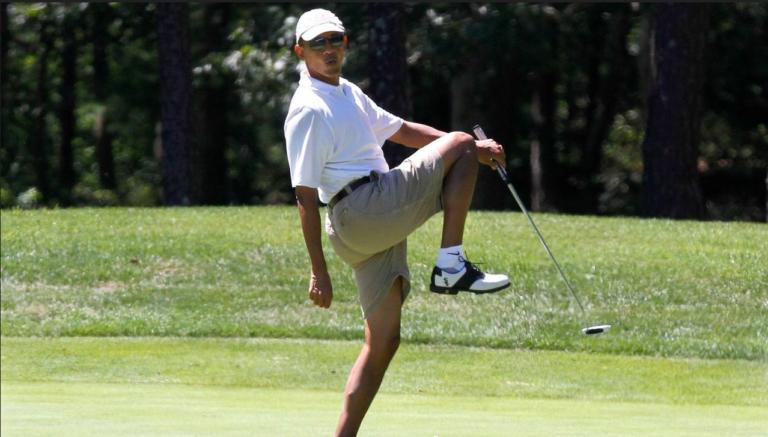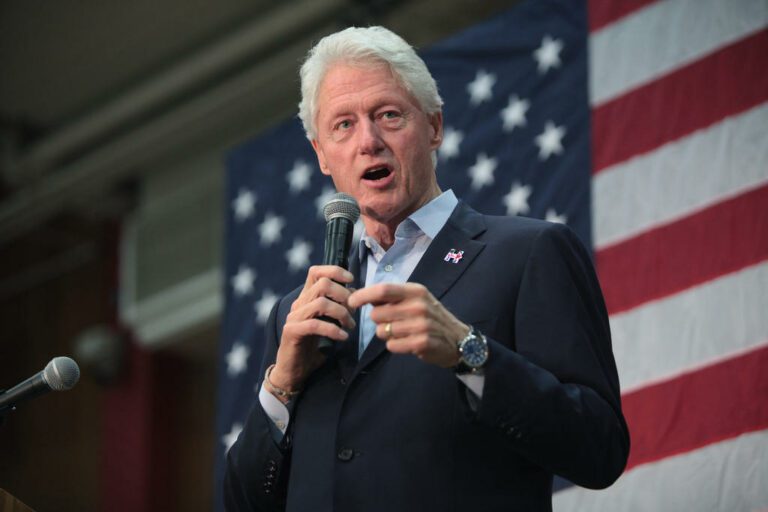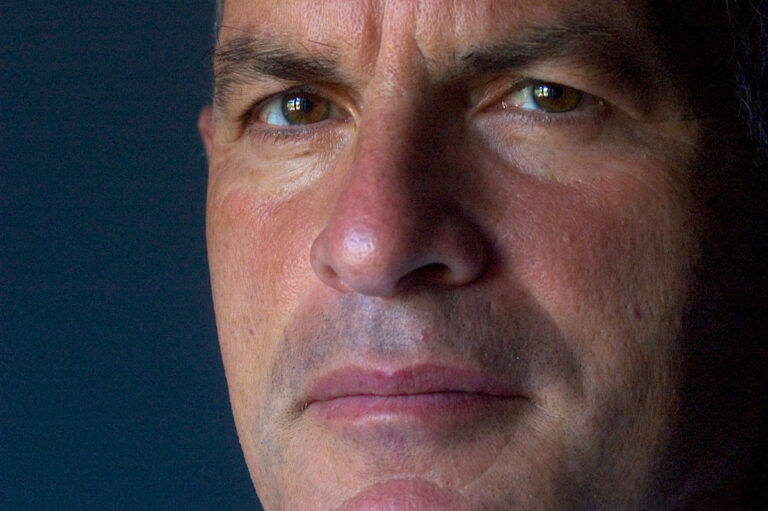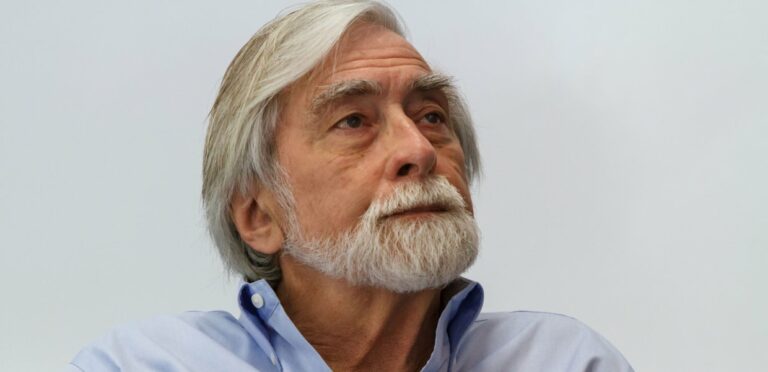This interview was originally published on October 16, 2014. Dr. Kumar tells Paul Jay that Muslim characters on Homeland are either terrorists, sympathizers of terrorists, or “good Muslims” which means pro-US.
PAUL JAY, SENIOR EDITOR, TRNN: Welcome back to Reality Asserts Itself on The Real News Network. I’m Paul Jay, and we’re continuing our discussion about Islamophobia in America with Deepa Kumar, who joins us in the studio.
Thanks for joining us.
So, one more time, Deepa teaches at Rutgers University, and her recent book is Islamophobia and the Politics of Empire.
So we’re going to talk about Homeland. And I guess–well, here’s a photograph of how the latest season of Homeland‘s being promoted. And I guess it’s like Little Red Riding Hood in the midst of some dark, horrible forest or something. I don’t know what she’s doing with a red hijab. But anyway, she’s trying to be undercover and stand out. It kind of doesn’t do the job, but it’s a pretty effective photograph. And here’s a little scene from Homeland that we’re going to talk about.
~~~
JAY: So, listen, I watch Homeland. I have to admit. Full transparency. I have seen every episode. It’s compelling television. And, yes, it’s one of the most reactionary things I’ve ever seen, except for maybe 24. I was saying earlier that the only thing I can remember that’s more reactionary than that is I Was a Communist for the FBI, which was pretty bad, in the 1950s.
Anyway. But you’re watching it, aren’t you?
DEEPA KUMAR, ASSOC. PROF. MEDIA STUDIES AND MIDEAST STUDIES, RUTGERS UNIV.: I am, I’m suffering through it, because I’ve written about it and I’m going to continue to develop my critique of it.
JAY: Alright. So let me try to give what I suppose the defense if I was their defense attorney. They would say, listen, the bad guy in the first couple of seasons, Nazir–Abu Nazir, was it?
KUMAR: Yes.
JAY: His son is killed in a drone strike. Brody, the made American character, he’s there. He’s been captured, but at the time he’s being kind of brainwashed by Nazir. But he’s there when the little boy gets killed. And isn’t that some attempt to give a human motivation to Abu Nazir? His fury comes because his son was killed. So why is that Islamophobic stereotyping?
KUMAR: So there are various kinds of Islamophobia. There is the more sort of troglodyte version, which is just blatant Islamophobia, and then there are these very complex, sophisticated, and liberal forms. And certainly they do show his anguish around losing his son and what drone strikes actually look like and so forth.
But for the most part, if you look at the Muslim characters on Homeland, they are either people who are terrorists, or sympathizers of terrorists, or they are good Muslims, which is people who actually support what the U.S. is trying to do, and there’s nothing in the middle. So, for instance, why focus on Abu Nazir, who takes to political violence, when you could have easily taken from real life a person like Malalai Joya, who is a progressive activist and was a–.
JAY: Well, then you don’t have a show.
KUMAR: Well–.
JAY: Come on!
KUMAR: You’d have a different show.
JAY: No, you wouldn’t have a show, ’cause nobody would buy it. No. It’s a good guy, bad guy thing, I mean, the premise of the show, unless you’re saying you can’t make this show without it being Islamophobic. But there aren’t–.
KUMAR: But if you’re going to make the bad guy a Muslim–and Brody is a bad guy in the first season, right, and every time he goes off to pray in his garage in secret, there’s this eerie music, like, as if the very practice of Islam is something bad. And when his wife first discovers he’s converted, she has a fit. You know, she can’t believe. It’s like it’s a betrayal of everything that the West stands for. And, actually, that’s how I read that image that you showed as well, because you look at it, it’s a sea of nameless, faceless women against this individualist, this woman in red who stands out. And it’s really the white man’s burden has become the white woman’s burden, and it’s a clash of civilizations.
And so, yeah, I think any show that presents characters that are one-dimensional–and a lot of these characters, the Hezbollah leader, for instance, and–.
JAY: Who beats his wife.
KUMAR: Who beats his wife, or the guy–I forget his name, but the Iranian operative who they’ve turned, and he comes back and kills his ex-wife–you know, these are misogynists and so on. And that perpetuates the notion that somehow every Muslim is a misogynist, which is not true.
JAY: Yeah, and there’s no–I mean, there is some basis in reality. There are Islamic groups out there, at least they call themselves Islamic (I think a lot of people who believe in Islam don’t really think they’re really even Islamic, but they certainly call themselves that), who do want to use terrorism as a tactic against civilian populations, sometimes in the United States, sometimes elsewhere. I mean, I think they probably have killed a lot more Shia than they’ve killed Americans. That being said, that’s still terrorism. I mean, there’s some basis in reality for this show to say these are the characters. I mean, right now there’s no Finns blew up anything in the United States. So there’s a reason. It’s–.
KUMAR: Well, I would–.
JAY: But let me just add one more thing.
KUMAR: Okay.
JAY: It’s not completely ahistorical, because the drone attack suggests this has something to do with U.S. policy in the Middle East.
KUMAR: Right. Right. This is a completely exaggerated threat. I agree with you that it’s not a nonexistent threat, but if you actually look at the number of Americans–the last year for which I checked–I think it was 2012–you look at the number of Americans killed internationally by terrorism-related incidents, you get a grand total of something like 18. So does the threat exist? Yes. But is it as a big a threat as some of the other ways in which Americans die, such as lack of access to health care and so on? No.
JAY: The counterargument will be it’s because there has been more effective counterterrorism tactics. I have no idea whether that’s true, but there might be some truth to it.
KUMAR: I don’t think so, because in fact groups like ISIS actually get to recruit more forces to their side when the U.S. responds in the way that it does in its war on terror, by going around bombing Syria and Iraq and killing innocent people and by blowing up grain silos and pharmaceutical plants, for instance, in Sudan and so forth. This is the very basis of the recruitment propaganda that these groups actually have.
JAY: Yeah, I think there’s lots of evidence that’s true. But there may also be true that in terms of preventing attacks in the United States, that this massive surveillance state may well have blocked some of these attacks. They’re arresting here people here and there.
KUMAR: Well, not according to some of the insiders, right? The two senators who have been extremely critical of NSA surveillance, Udall and Wyden, have actually looked at the intelligence information and said that in fact this mass surveillance hasn’t actually stopped any significant terror plot. And Trevor Aaronson’s book The Terror Factory, he actually argues that the vast majority of plots that get stopped are actually plots created by the FBI, right, through a process of entrapment. They go, they prey on the–.
JAY: Yeah, most of the arrests seem to be someone has sold something to FBI agents or have bought something from FBI agents.
KUMAR: Right. And, conveniently, when these people, such as the Newark Four, right–these are people who are really poor African-Americans–need the money that the agent provocateur is providing them and so on, and then they agree to go ahead and bomb the synagogue, and just in the nick of time you have television, you have the police–and it’s a spectacle, really.
And, again, domestically, let’s look at the statistics. In the two decades before 2010, the number of terrorism-related deaths that Muslim Americans are responsible for is about 20, whereas in that same time period the far right, the neo-Nazis, the white supremacists are responsible for 350 deaths. And yet our focus is not on those people. In fact, in 2010, when the FBI, I believe, put out a report about the rise, after Obama’s election, of white supremacist groups, there was such a backlash that that unit that produced this report was dissolved.
So who we focus on as being a threat, as being an enemy to the homeland, and so on is very much a political narrative in the same way that Khorasan, the group that all of a sudden–none of us had heard of it, and Glenn Greenwald actually has this expose at The Intercept which shows that it was a concoction of the U.S.
JAY: Maybe it shows it.
KUMAR: Maybe.
JAY: I wasn’t totally persuaded by that article. Three-quarters of the article is giving the track of how the story came out, and then at the end it’s sort of they retreated from the story. But–.
KUMAR: Well, I suppose he has some counterterrorism officials who are coming forward and saying, well, we’ve never heard of this group and where did they come from.
JAY: But it seems to me that in trying to say that there’s not really a threat or the threat’s being exaggerated, I don’t know if we know that. But I think what we do know is that the threat originated because the American policy has destroyed this region.
But you can then create real monsters. I mean, we were saying in the last episode, I think to a large extent American policy helped create Hitler. But Hitler then became a real monster. And so, I mean, I don’t know how effective this counterterrorism stuff has been, and I think it may be a mistake to underestimate that there are forces out there that want to attack.
KUMAR: Right.
JAY: And part of it is that there’s an underlying hypocrisy here, which I think needs to be said, which is it’s okay when Americans kill civilians, ’cause you can call it collateral damage, or Israelis kill civilians, you can call it collateral damage. But it’s obvious in World War II, when you’re firebombing Hamburg, or when you drop nuclear weapons on Japan, you’re killing civilians and you know you are. But that’s okay; that’s not a tactic. It’s only a tactic in warfare. But if IS blows up something here, well, they’re at war with the United States. Why isn’t that just a tactic of warfare?
KUMAR: Right. And the fact of the matter is these sorts of questions aren’t debated in the mainstream. Instead, the propaganda line from the White House is the one that we keep hearing again and again.
I mean, again, I want to push back on the idea that somehow terrorism is a threat to such an extent that we should have an entire national security apparatus dedicated–.
JAY: Oh, well, if you’re pushing back with me, that’s not my answer.
KUMAR: Okay.
JAY: My answer is get the hell out of the Middle East.
KUMAR: Yes.
JAY: That’s my answer.
KUMAR: Absolutely. And you remember what irritated Osama bin Laden. It was U.S. troops in Saudi Arabia, in the holy land. Nine/eleven could have been prevented if the U.S. hadn’t done that.
So, yes, we have a huge counterterrorism apparatus that goes around entrapping people and that goes around–they were in my school, actually, you know, infiltrating college groups and so on. Does that make us safer? I don’t think so.
JAY: No, I don’t think you can be the world hegemon and have rights at home. I don’t think you can be the world’s hegemon and have security at home. Eventually people want to bite back.
The biting back, I think, is real. Whether it’s of this scale or this scale I don’t know, ’cause I don’t have the intelligence. I fully believe that there’s plenty of people that would like to blow stuff up in the United States.
You want security, stop messing with everybody all over the world. That’s the–you’re not going to have security any other way.
KUMAR: That’s right.
JAY: I’m just saying there is a real–there may be a real threat out there. The solution’s not a hammer; the solution is get out of their lives.
KUMAR: But the question also is: how do we think of security in this country? Right? And how important do we think it is? I’m thinking back to Michael Moore’s film Bowling for Columbine. And he has this clip where he shows how Canadians leave their houses open when they go out.
JAY: Yeah, that was nonsense.
KUMAR: It’s nonsense? Okay.
JAY: Nonsense. I’m Canadian. I don’t know anyone that didn’t lock their doors.
KUMAR: Okay. But there is a paranoia–.
JAY: The rest of the film’s pretty good, but that was an exaggeration.
KUMAR: But there certainly is a paranoia in this country around security. And that doesn’t come out of the blue. It’s a process that’s been cultivated. And this is a piece that I’m working on with Arun Kundnani, where notions of security are always a racialized notion of security. It’s always about protecting the white family from the Native American threat, from the black rapist threat, from the brown terrorist threat. And that creates the mindset in which you can justify militarism.
JAY: Okay, but it’s not just a mindset. There is more–certainly, unfortunately, in Baltimore it’s more poor–black poor on black poor crime. But it’s not just a mindset. Like, native Indians were violent against whites ’cause their land was being taken away.
KUMAR: Sure.
JAY: But does it mean they weren’t fighting? Yeah, they were fighting. Don’t want them to fight, don’t steal their land.
KUMAR: Yes.
JAY: I mean, it’s not just a mindset that people should be concerned about urban black poor or Latino poor. I mean, it’s reality. Yeah, you’d better be concerned, because they’re living in such poverty, and you’re living in gated communities. And, unfortunately, too much crime is poor on poor, but maybe someday they will be knocking on the gates of gated communities, and for good reason.
KUMAR: Well, the question is: how do we frame crime? Right? How do we look at questions like theft? How do we look at the responses, violence, you know, among poorer communities and so on?
And the language of law and order that we see developing from the 1970s on comes up in a very particular context, which is to push back against the movements of the 1960s. I mean, you think about the civil rights movement, and it was about civil disobedience. It is about breaking the law. But that becomes a means by which to say, don’t let these black people get too far ahead, because they’re going to disrupt the kind of white order that we actually have, and let’s criminalize them. And we’ve seen the systemic sort of way in which what Michelle Alexander calls “the new Jim Crow”–where you’ve seen a disproportionate number of African-American men in particular being thrown behind bars in the war on drugs.
And so, again, the question for us is: what causes the things that we call crime today, right? And whose safety is being guarded here? And it’s typically white people who are being asked to fear brown and black people. And then we militarize the police as the solution, as opposed to economic development in Ferguson or what have you.
JAY: Yeah, because if you go down the road of economic development, it’s a really profound question, ’cause then you get to who owns stuff and who has power, and you get to this tiny little section of the elite, and then you have to challenge the form of ownership and how power is used. And they don’t want to have that conversation.
KUMAR: No. And, in fact, the 1 percent largely likes to stay invisible. But they’re building little fortresses to keep themselves safe, you know, all sorts of gated communities and security barriers that you have to pass through in New York City and elsewhere, which makes it a kind of scary world to live in.
JAY: Alright. So let’s get back to Homeland. There seems to be only two types of possible Muslims in this: either you’re with Abu Nazir or you’re pro-American. And that seems to be the only piece of the Islamic landscape.
KUMAR: Absolutely. Mahmood Mamdani actually refers to this framework as “good Muslim, bad Muslim”, which is, if you have any kind of position, a politically progressive position or what have you, if you’re opposed to the U.S.’s agenda, you’re automatically a bad Muslim. And if you are a collaborator with empire, then you’re a good Muslim. And that’s all you ever get to be.
But what’s interesting is that this typology is not new. In the research that I’m doing for a piece on race, surveillance, and empire, it actually goes back to the 18th century, when native peoples, indigenous people, were actually studied and surveilled in a very systematic way and tribes were demarcated according to good Indians and bad Indians, right, the good Indians who were for the colonial settler mission and the bad who were not. And so, in that sense, empires, and the U.S. as an empire, always creates just two positions for people to be in.
JAY: And then they merge everything, which is part of this Islamophobia. Like, everybody’s kind of the same mishmash. I mean, first of all, it made no sense in the show that it’s the Iranians that blew up the CIA headquarters. It’s revenge for something, but it made no sense. But [what] even made more no sense is they’ve got Hezbollah–
KUMAR: Working with al-Qaeda, yes.
KUMAR: –working with al-Qaeda, and anybody that knows anything knows that al-Qaeda hates Hezbollah more than they hate Americans.
KUMAR: Yes. That’s absolutely right.
I mean, the way that Orientalism or Islamophobia works is you create an amalgamation of all of these people, you completely disrespect the differences, and you create this monster terrorist threat where everybody is collaborating. So, for instance, Beirut, if anyone has been to Beirut, in Lebanon, there’s a scene on Hamra Street. Hamra Street, for those who’ve been there, know it’s a super posh street and–.
JAY: Yeah, filled with American billboards, jeans, Gap, and this and that.
KUMAR: Exactly, Starbucks and so forth. I’ve been to the Starbucks there. And there are Americans, there are Europeans.
And the scene in Homeland, you have Carrie, who’s the main protagonist, you know, sort of wearing a headscarf and just skulking along, and it’s this dark and eerie and horrible place, when in fact that’s not at all the reality of what it is.
JAY: I mean, there are streets like that.
KUMAR: Sure, but it’s not Hamra Street. And instead what you have is Arab land, which is this awful, terrible place, and they’re all the same. Everything is the same.
And you look at this character Roya Hammad–she’s supposed to be Palestinian. She’s a journalist. Well, Roya’s actually an Iranian name. But, you know, we’ll mish them all up together and create this uniform monolithic enemy. That’s what’s happening.
JAY: Yeah. I mean, I guess the bottom line we’ve said earlier, but just to say it again, there is–you know, the Middle East has this barbaric Islamic features. They do exist. They certainly don’t represent the majority of Islam, but that’s not the most important point. The most important point is these barbaric features were created deliberately–consciously, deliberately created–by U.S. policy. And that never gets talked about in Homeland.
KUMAR: Right. And furthermore, we never reflect on our own barbarians, right, whether it’s Christian fundamentalists, it’s the Tea Party, and so on.
JAY: Well, I think the American government is.
KUMAR: Yes.
JAY: No, really. In terms of who–I mean, if they killed as many as 1 million Iraqis, they don’t hold–Islamic State and Abu Nazir and the rest of them, they don’t hold a candle to what the United States has done.
KUMAR: Absolutely.
And, again, the last thing I want to say about that poster for the next season is it’s premised on the notion that somehow women are liberated in the U.S. whereas they are uniquely oppressed in the Middle East and North Africa and in South Asia and so forth. And people who’ve never traveled outside of the country, people who’ve never met somebody from Egypt, from Iran, from Pakistan, all seem to know that women in the Middle East are horribly, horribly oppressed.
And the question is, we have to ask, where does that notion come from? And why is it that we don’t talk about the oppression of women right here? You know, one in five women will be raped in this country. One in four face severe physical abuse at the hands of a domestic partner. Every year, 1,500 women are killed by intimate partners. Can you imagine if we had news coverage of the three women who died just today at the hands of their intimate partners and it was covered in the same way as the beheading of the two journalists, two American–. We would have such a different attitude about sexism in the United States, misogyny, and violence that exists right here just as it does in the Middle East, just as it does in Pakistan and elsewhere.
JAY: Alright. Thanks.
So join us for the continuation of our discussion with Deepa Kumar. We’re going to talk about the origin of the terrorist threat and the whole origin and development of the national security state on Reality Asserts Itself on The Real News Network.
Never miss another story
Subscribe to theAnalysis.news – Newsletter
“Deepa Kumar is an Indian American scholar and activist. She is a professor of Journalism and Media Studies at Rutgers University.”






